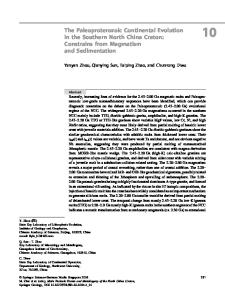Structural evolution of continental and marine Permian rock salt of the North German Basin: constraints from microfabric
- PDF / 11,588,993 Bytes
- 19 Pages / 595.276 x 790.866 pts Page_size
- 0 Downloads / 306 Views
ORIGINAL PAPER
Structural evolution of continental and marine Permian rock salt of the North German Basin: constraints from microfabrics, geochemistry and U–Pb ages Mareike Henneberg1 · Jolien Linckens2 · Michael Schramm1 · Jörg Hammer1 · Axel Gerdes2,3 · Gernold Zulauf2 Received: 8 April 2020 / Accepted: 28 June 2020 © The Author(s) 2020
Abstract Analyzing the dynamics of microstructural response on natural deformation in rock salt, we present microfabric, EBSD, geochemical and U–Pb data, obtained from Permian salt formations of the Kiel-Honigsee salt wall in Northern Germany. The samples were recovered from deep drillings, which penetrated through an overturned rock salt sequence of both Rotliegend and Zechstein deposits. The bromide concentration in halite indicates a continental and marine origin for the Rotliegend and Zechstein deposits, respectively. Despite intense deformation, relics of early diagenetic fabrics are still preserved. Deformation of the impure Rotliegend rock salt was accommodated by pressure solution and hydrofracturing as is indicated by the microfabrics and bromide concentration in halite. Fractures in siliciclastic domains were filled with fibrous halite and deformed by subgrain rotation recrystallization (SGR). Fluid-rich Zechstein rock salt, on the other hand, was deformed by formation of subgrains and grain boundary migration (GBM). The distribution of mineral phases and fluids had a significant impact on the fabric evolution and on strain localization. U–Pb dating of carbonate phases of the Rotliegend sequence yielded Permian depositional ages and Jurassic to Cretaceous deformation ages, the latter related to diapiric ascent. The combination of results traces a dynamic evolution of the rock fabric inside the diapir structure driven by locally active deformation processes that can be correlated with early stages of halite deposition and diagenesis and syntectonic fabric reorganization related to diapirism in an extensional setting. Keywords Rock salt · Halite · Microstructures · Diapirism · North German Basin · Evaporite · Geochemistry · U–Pb dating
Introduction Salt diapirs consist of various types of salt rocks, comprising halite and non-halite evaporites, which differ not only in composition, but also in effective viscosity (Borchert and Deceased: Jörg Hammer. Electronic supplementary material The online version of this article (https://doi.org/10.1007/s00531-020-01905-w) contains supplementary material, which is available to authorized users. * Mareike Henneberg [email protected] 1
Bundesanstalt für Geowissenschaften und Rohstoffe (BGR), 30655 Hannover, Germany
2
Institut für Geowissenschaften, Goethe-Universität Frankfurt am Main, 60438 Frankfurt am Main, Germany
3
Frankfurt Isotope and Element Research Center (FIERCE), Goethe-Universität Frankfurt am Main, 60438 Frankfurt am Main, Germany
Muir 1964; Raith et al. 2016; Rowan et al. 2019). The difference in viscosity of individual layers is related to the deposition and diagenesis of the sedimentary
Data Loading...











